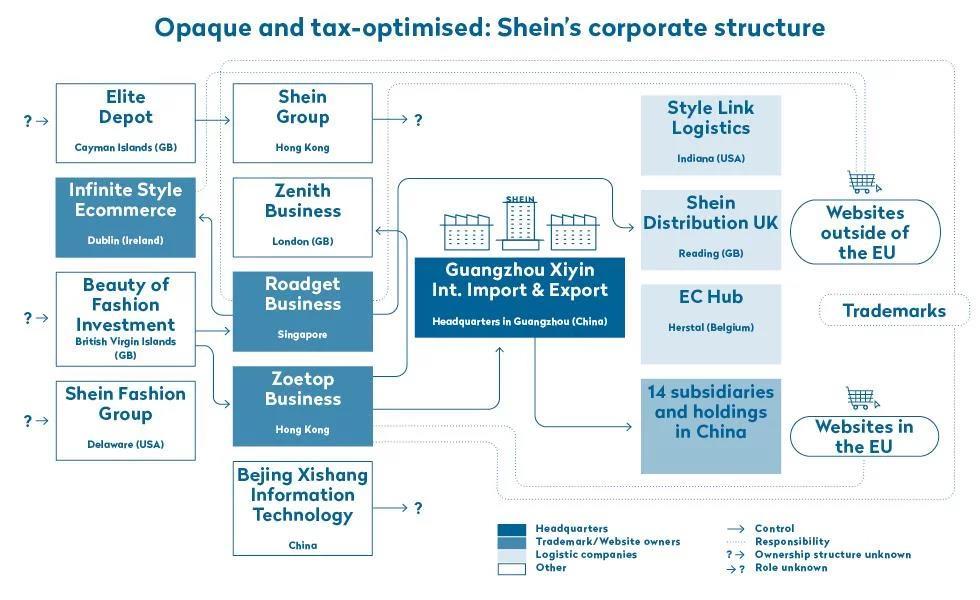If you know about “fast fashion,” you surely have heard of the Chinese fast-fashion giant, Shein. It is a favorite of those who desire cheap clothing in a seemingly infinite and ever-changing selection of styles. Despite, and perhaps partly because of its worldwide dominance and popularity, Shein has been a magnet for legal and ethical accusations, including trademark disputes, tax evasion, human rights violations, and health and safety concerns.
Shein was the subject of a Congressional Issue Brief published by the U.S.-China Economic and Security Review Commission in which it described Shein’s business model:
Shein’s business model is distinguished by its reliance on tracking and analyzing user data. Founded by Chris Xu, a Chinese national with a background in search engine optimization, Shein draws on customer data and search history with the assistance of artificial intelligence (AI) algorithms to discern emerging fashion preferences and patterns. With these rapid insights, Shein can begin manufacturing and delivering clothes to market ahead of competitors. To aid its data collection, the company’s app also requests that users share their data and activity from other apps, including social media, in exchange for discounts and special deals on Shein products.
The Commission also raised concerns about Shein’s business practices, including forced labor, health hazards, environmental impact, copyright infringement and tariff avoidance.
This brings us to a recent copyright infringement case against Shein, Perry et al. v. Shein Distribution Corp., et al., brought by three independent graphic designers who allege that Shein infringed certain designs by creating exact duplicates of plaintiffs’ works and placing them on clothing. The complaint is a no holds barred, far-reaching indictment of Shein. The plaintiffs not only assert claims in copyright infringement, but accuse Shein of racketeering under the civil RICO Act, a relatively rare allegation in a copyright infringement suit. To establish the RICO claim, plaintiffs present detailed allegations about Shein’s corporate structure, and alleged criminal and civil misconduct. There is insufficient space here to recount the detailed allegations of the complaint, but here are some bulleted highlights:
- Shein has no brick-and-mortar stores, but rather it is a technology company with a huge dominance in social media;
- Shein is unconcerned about taking public relations hits, but allegedly absorbs legal and reputational damage by settling cases quickly and creating an obtuse corporate structure, which is difficult to understand and penetrate;
- intellectual-property theft is “baked into its business model”;
- Shein’s secret algorithm generates products that are exact copies of works created by other designers;
- Shein manufactures limited initial quantities of new designs for the purpose of determining whether it will receive infringement claims and, if it does, speedily “cease and desists” (referred to by the plaintiffs as a “testing-the-waters approach”);
- most infringements by Shein go unnoticed or go beyond the financial reach of small, independent designers who are victims;
- although it portrays itself as such, Shein is not a single integrated entity, but rather a “decentralized constellation of entities, designed to improperly avoid liability.”
- Shein utilizes a byzantine corporate structure for the purpose of “making it impossible for intellectual-property plaintiffs to figure out who to sue.”
To underscore the latter point, plaintiffs refer to a diagram of Shein’s complicated corporate structure:
So, with a corporate structure like that, who the heck do you sue? From Shein’s perspective, that may be the point (remember, these are allegations). From plaintiffs’ perspective, that is the point. In paragraphs 109 and 112 of plaintiffs’ RICO claim, the complaint states:
… The Enterprise [i.e., the Shein entities] is made up of the persons, entities, and associations that include those listed above—and likely additional participants that Plaintiffs have not yet discovered despite diligent efforts. As described above, Defendants had a role in the using the Enterprise to conduct racketeering activity that was distinct from the undertaking of those acting on its behalf. Defendants also attempted to benefit, and did benefit, from the activity alleged herein, and thus was not a passive victim of racketeering activity, but an active perpetrator.
….
The Shein Enterprise constitutes a group of persons associated together for the common purpose of operating the Shein overall business, which includes as an integral part, a systematic and continuous pattern of criminal copyright infringement, as alleged in detail above.
So, you see, plaintiffs pull no punches. Keep in mind that these are simply allegations and that plaintiffs bear the burden of proving them in court. It will be interesting to learn whether the plaintiffs go the distance and attempt to obtain a judgment against Shein or will go the way of other victims and simply settle the case. We will keep you informed.
— Adam G. Garson, Esq.



